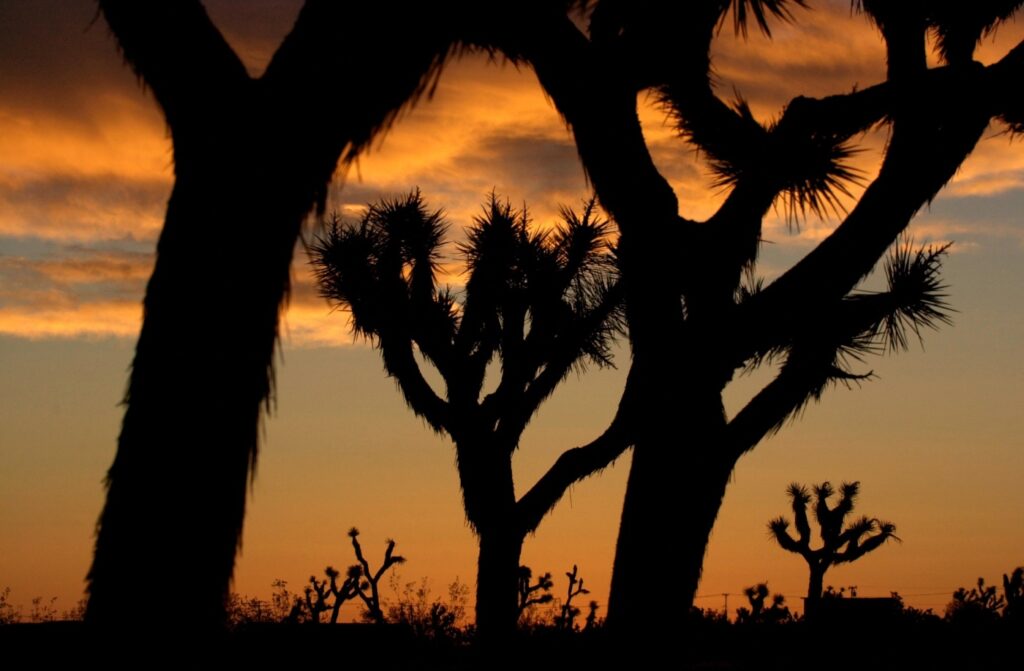
San Bernardino County doesn’t think Joshua trees are threatened — but officials do think they’re valuable. And if you mess with them, you’ll pay a price.
At its Tuesday, May 24, meeting, the San Bernardino County Board of Supervisors approved new penalties for the “unlawful removal” of Joshua trees in the county. The board approved the penalties unanimously, without comment, as part of the consent agenda, on which non-controversial items are approved en masse.
Previously, illegally removing a Joshua tree was a misdemeanor, punishable by up to a $1,000 fine.
But once the ordinance is adopted — currently scheduled for June 14 — violators will be subject to escalating fines, starting at $5,000 for a first conviction, $10,000 for a second conviction and up to $20,000 or imprisonment for up to six months, or both, for a third violation.
Tuesday’s decision wasn’t made in a vacuum.
There have been increasing calls to protect the plants — which are actually succulents, not trees — in recent years.
A paper published in June 2019 by researchers at UC Riverside’s Center for Conservation Biology, and other institutes, predicts that at least 80% of the Joshua trees in Joshua Tree National Park will be wiped out by 2100.
Climate change has made summer temperatures in the park higher than ever and winter temperatures even lower. Strands of trees that have stood for thousands of years will likely die off, leaving only those in the highest elevations, although continuing climate change will eventually get them too, according to researchers.
According to the 2019 study’s worst-case scenario: The 160,000 acres of Joshua Tree National Park capable of supporting the iconic trees will drop to just 37 acres by 2100.
County officials have rejected the notion that the trees are in danger.
“Scientific evidence does not demonstrate that populations of the western Joshua tree are negatively trending in a way that would lead the (California Department of Fish and Wildlife) to believe that the western Joshua tree is likely to be in serious danger of becoming extinct throughout all or a significant portion of its range in the foreseeable future,” the resolution approved by the board Tuesday states.
A March 2022 report from the department of fish and wildlife called the trees “abundant and widespread,” lessening the threats to the species.
“The scientific evidence that is currently possessed by the department does not demonstrate that populations of the species are negatively trending in a way that would lead the department to believe that the species is likely to be in serious danger of becoming extinct throughout all or a significant portion of its range in the foreseeable future,” the report states.
But San Bernardino County officials think there’s a reason to protect the trees. The ordinance states that Joshua trees have “significant psychological and tangible benefits for both residents and visitors,” serve as a symbol of the region and contribute to the region’s economy.
Tuesday’s actions may also be supervisors getting ahead of June’s meeting of California’s Fish and Game Commission.
On Oct. 21, 2019, Brendan Cummings, an attorney for Center for Biological Diversity, filed a petition to list the western Joshua tree — one of two species of Joshua tree, and the one associated with Joshua Tree National Park — as threatened under the California Endangered Species Act. The trees — found only in the Mojave Desert — are in danger due to climate change, fire and development, according to Cummings.
In September 2020, the commission temporarily put the Joshua trees under state protection while they considered a permanent change to the trees’ status. The panel is scheduled to take up the matter, and make a permanent ruling on whether Joshua trees should be treated as a threatened species, at its June 15 and 16 meeting.
“This is a cynical move for the county to paper over the fact that they’ve been abysmal in terms of implementing and enforcing ordinances to protect Joshua trees,” Cummings said Tuesday. “They’re passing this so they can wave it around in front of the state fish and game commission in three weeks’ time saying ‘We don’t need need additional protections, we’re passing ordinances down here.’”
Right now, the county doesn’t have the ability to issue permits for developers to move or remove Joshua trees. Only the state does.
More on Joshua trees
Agency considers protection for Mojave Desert’s iconic Joshua trees
Can Joshua trees survive global warming? Scientists have differing thoughts
Why Joshua Tree National Park smashed its attendance record in 2017
Why Joshua Tree National Park may be saying goodbye to most of its iconic trees in the next 81 years
Joshua trees should be protected by state endangered species act, group says
“It’s been well-established that San Bernardino County’s previous management of Joshua trees was woefully inadequate,” Cummings said. “This is their attempt to say ‘Hey, we take Joshua tree management seriously. We don’t need state protection; we can do it ourselves.’”
The higher fines look good on paper, he said, but historically, the county hasn’t enforced the penalties already on the book.
“Higher penalties are good, but they only matter if the county is serious about enforcing them,” Cumming said.
As for what will happen at the Fish and Game Commission meeting in mid-June, Cummings is “cautiously optimistic.”
“If they follow the science and the law, then they should be protected as a threatened species,” he said.
